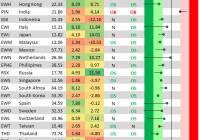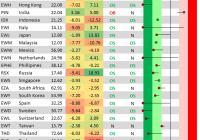
Macro, currencies, arbitrage, statistical analysis “}); $$(‘#article_top_info .info_content div’)[0].insert({bottom: $(‘mover’)}); } $(‘article_top_info’).addClassName(test_version); } SeekingAlpha.Initializer.onDOMLoad(function(){ setEvents();}); Norway’s stock market has come under short-term pressure owing to growth concerns arising from lower oil prices. I still maintain that Norway’s stock market is undervalued relative to Sweden’s. However, it could take longer than anticipated for the Norwegian market to reach fair value. On June 3 , I had published an article arguing that a possible pairs trading opportunity exists through taking a long position on the Norwegian stock market through the iShares MSCI Norway Capped ETF (BATS: ENOR ) and a short position on the Swedish stock index through the iShares MSCI Sweden Index Fund* (NYSEARCA: EWD ). However, for this month we have seen the Norway ETF decline by 3.35 percent from $25.02 to $24.18, while the Swedish ETF has also declined by 2.57 percent from $34.97 to $34.07. The drop in Swedish stock market performance was not surprising and in line with my initial expectations. I had previously anticipated that lower than expected growth could translate to lower stock market returns as a result, and this has been the case for the month of June; with the consumer confidence indicator falling to 97.9 this month from a previous 99.0 in May. However, the decline in Norwegian stock market activity was less anticipated. Firstly, it appears that the Norwegian economy as a whole is still sensitive to oil price fluctuations, as the overnight deposit rate was cut to 1 percent this month as the effects of lower oil prices begin to take their toll on economic growth. Moreover, while lower wage growth remains a concern, house prices continue to rise in Norway which may give rise to speculation of a credit bubble similar to that of Sweden. For instance, it is anticipated that on the whole, Norwegian citizens now owe creditors twice as much as they make in disposable incomes. Additionally, house prices have increased by 7.5 percent in May from the previous year. In this regard, does the aforementioned pairs trading strategy still hold merit? It does if you have patience. Norway’s stock market remains undervalued on a P/E basis, and a major reason behind my bullish view on Norway was that various companies in the oil and financial sectors trade at lower than average P/E ratios while continuing to show impressive returns. However, it could take longer than anticipated for fair value to be reached as Norway grapples with short-term economic problems. In this context, this pairs trading strategy is best oriented over a longer-term horizon; i.e. 1 year or longer. *Note: The iShares MSCI Sweden Index Fund is not an inverse ETF and an investor would need to short-sell to take a short position in this instance. Disclosure: I/we have no positions in any stocks mentioned, and no plans to initiate any positions within the next 72 hours. (More…) I wrote this article myself, and it expresses my own opinions. I am not receiving compensation for it (other than from Seeking Alpha). I have no business relationship with any company whose stock is mentioned in this article. Share this article with a colleague


